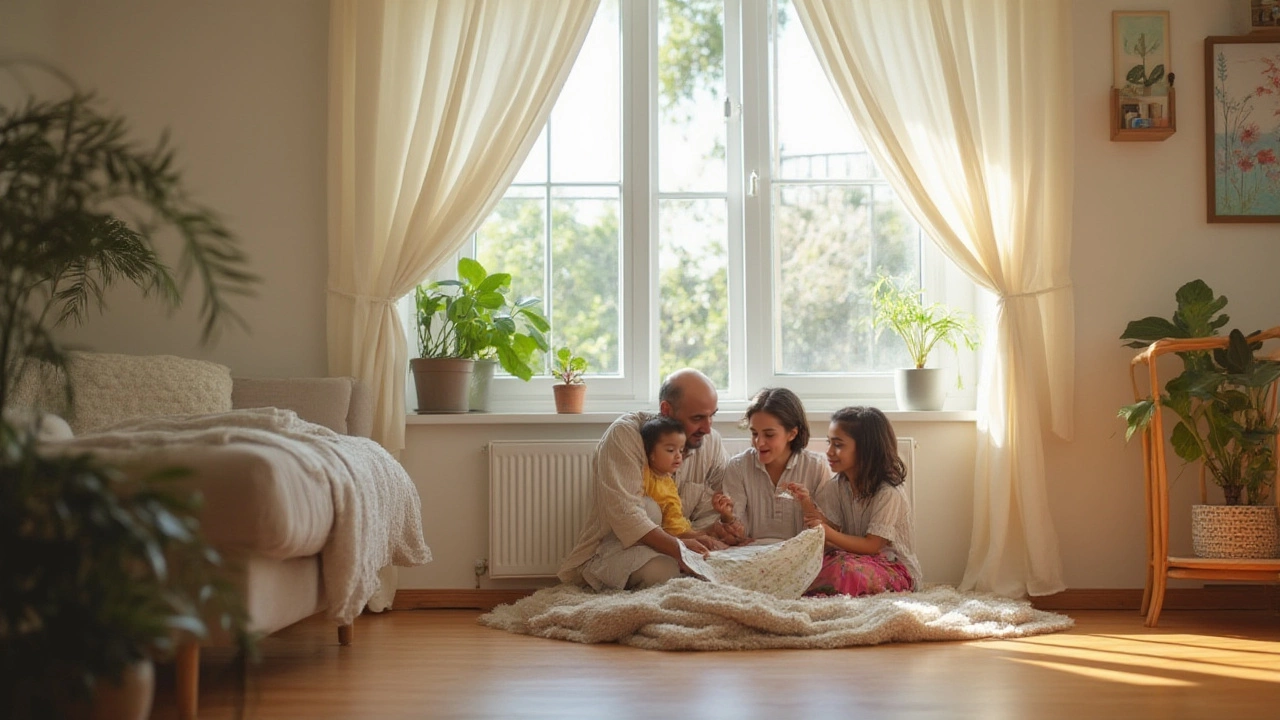
If you’ve ever stood in the curtain aisle at a big-box store, flustered and second-guessing whether you need 84-inch or 96-inch panels, you know this isn’t just a small detail. Curtain length messes with the type of vibe your room throws out there. Go too short, and things feel awkward or unfinished. Go too long, and you might create a tripping hazard—or at least a haven for dust bunnies. So, should curtains touch the floor or stop at the baseboard? It sounds simple, but behind all those pretty Pinterest photos are real trade-offs involving function, cleaning, and style.
The Debate: Floor-Length Versus Baseboard Curtains
If you peek into model homes or scroll your favorite design feeds, you'll notice floor-sweeping drapes in the background of almost every photo. That look tends to channel luxury and intentional design. The reason? When curtains *just* touch the floor or puddle slightly, they draw the eye down and visually stretch the wall, making the ceiling seem taller. It's a trick decorators have used for over half a century, and it still works.
Here's the thing, though: Not every room (or person!) is set up for this. If your window sits right above a heater or an outlet, letting fabric fall onto the floor may not play well with fire safety or practicality. Pets and toddlers also love to yank on whatever brushes the ground, so floor-length curtains sometimes spell disaster in family spaces.
On the flip side, curtains that stop at the baseboard—or even a couple inches above—feel crisper and tidier. Think about the classic café curtains in a 1950s kitchen. These are functional, quick to clean, and immune to the chaos of muddy paws. They're also the norm in countries like Sweden, where windows were designed to open upward or inward, so shorter curtains never get in the way. Minimalists or those who like that sharp, modern look often go for a baseboard hover to keep lines clean and free of fuss.
What’s wild is how much mood this one choice sets. Walk into a room with ankle-skimming drapes and you get instant vacation-in-a-hotel energy. Walk into another with exacting baseboard height and it’s much more no-nonsense, businesslike. Each carries its own weight—literally and stylistically.
When Floor-Length Curtains Make Sense
Here’s the truth: Floor-length curtains aren’t always about showing off and looking fancy, even if that’s the reputation. They’re practical in certain cases. Have windows that reach almost all the way to the ground? In older homes or places with dramatically large sills, covering the wall-to-floor gap is about more than looks—it’s about blocking cold drafts and keeping out sunlight. Thermal curtains that hit the floor can save you money when winter winds start creeping in.
If you want to blend in a slightly ugly radiator, floor-grazing curtains do the job without adding bulk where you don't want it. And there are options: the subtle 'kissing the floor' length, which just barely brushes the ground—think of it as putting your curtains in the perfect pair of jeans. Or, if you’re bold, the ‘puddle’ look piles extra inches so fabric pools gently at the base. Designers in the 1920s used to say that puddling was for the romantic or messy-at-heart. It can soften strict lines and help with acoustics in big, echoey rooms.
One real-world tip: Always measure from your desired curtain rod height down to the floor with a metal tape, and do it in at least three spots per window. Floors and ceilings aren’t always perfectly level—especially in older homes. Avoid the high-water look by splitting the difference if you get odd results. And wash or steam your curtains before hanging, since some fabrics shrink on the first clean.
The biggest drawback? The floor gathers dust, so those extra inches become dust magnets. It means more cleaning, and the extra length can take a beating in high-traffic rooms. If you pick silk or linen, expect more attention and care.

Why Stop at the Baseboard?
Ending curtains at—or just above—the baseboard is the no-fuss option, but it flirts with risk if you cut things too short. Curtains that hover awkwardly above the windowsill can make a room feel boxed in or chopped up, sort of like wearing pants that are clearly too small. But cut them with precision—about half an inch above the baseboard or floor, so they never actually touch—and you get a tailored, fitted effect designers call a 'float.'
This style is magic for practical spaces. Kitchens, laundry rooms, and playrooms where spills, splashes, and sticky fingers are regular visitors love a curtain that keeps its hems dry. Add to that, high-moisture spots (like bathrooms) are breeding grounds for mold on soft materials, so lifting the fabric out of splash range is just smart.
Shorter panels mean less snagging on radiators and furniture, and for allergy-prone folks, there’s less fabric to trap dust and dander. The trend in Japanese and Scandinavian interiors favors this method, sticking to minimalism while keeping efficiency first. A neat trick: If you want some softness but keep things practical, try dual-layer treatments—floaty sheers for style, and practical blackout or thermal layers cut just above the baseboard for function.
One big tip is to avoid any visible gap between curtain and floor unless it’s intentional. Gapless, almost-kissing length feels deliberate and modern; a few inches of naked wall can feel careless. If you’re DIY-ing the length, always finish the hem after hanging to accommodate real-life quirks like uneven floors or warped woodwork.
Choosing the Right Length For Your Room
If you’re chasing the most stylish option for your space, it boils down to a few simple questions: What’s your room’s main function? Who actually uses the space? What’s your cleaning tolerance? Get specific about traffic, dirt, kids, and pets before caring about trends.
Bedrooms, living rooms, and formal spaces where texture and coziness matter can hugely benefit from those extra-long, almost-theatrical panels. Try pinch-pleated velvet that brushes (but never pools on) the ground for a ritzy but low-maintenance setup. Or go with a patterned linen and let it just graze the floor for a carefree, beachy feel. Don’t forget blackout layers behind the main panel for sleep and privacy.
When it comes to cleaning, baseboard-length curtains almost always win. If ease is your top priority, or if you share your home with muddy pets or boisterous toddlers, a barely-there float keeps you from replacing stained and shredded fabric every few months.
The technical side matters, too. Always hang curtains wider than the window—about 8 to 12 inches past the frame—to make windows look bigger and let more light in. And here’s a decorating secret: mount the rod as close to the ceiling as possible (at least 4-6 inches above the frame, if not more) for instant height, no matter what length you settle on.
When playing with styles, look at what fits your architecture. Victorian or Craftsman homes wear opulent drapes well; mid-century modern and bungalows prefer neat, un-fussy lines. Always match your hardware to your curtain weight to prevent sagging, because nothing kills a polished look faster than a drooping rod.
Once you nail the length, make it yours. Add trims, tassels, or stitched bands for personality, or swap out seasonally—featherweight in summer, heavier in winter. Curtain length isn’t just a measurement. It’s a style choice that shapes how a room feels and functions, so trust what fits your lifestyle, and don’t sweat breaking the so-called rules. The best homes are the ones that look like someone really lives there anyway.




